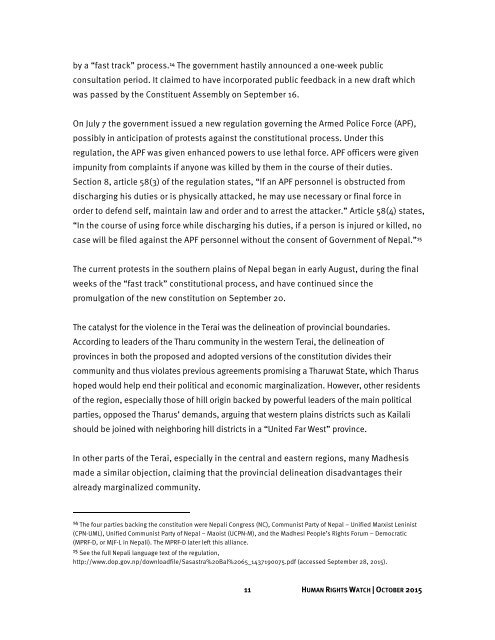“Like We Are Not Nepali”
7KiiNLWaT
7KiiNLWaT
You also want an ePaper? Increase the reach of your titles
YUMPU automatically turns print PDFs into web optimized ePapers that Google loves.
y a “fast track” process. 14 The government hastily announced a one-week public<br />
consultation period. It claimed to have incorporated public feedback in a new draft which<br />
was passed by the Constituent Assembly on September 16.<br />
On July 7 the government issued a new regulation governing the Armed Police Force (APF),<br />
possibly in anticipation of protests against the constitutional process. Under this<br />
regulation, the APF was given enhanced powers to use lethal force. APF officers were given<br />
impunity from complaints if anyone was killed by them in the course of their duties.<br />
Section 8, article 58(3) of the regulation states, “If an APF personnel is obstructed from<br />
discharging his duties or is physically attacked, he may use necessary or final force in<br />
order to defend self, maintain law and order and to arrest the attacker.” Article 58(4) states,<br />
“In the course of using force while discharging his duties, if a person is injured or killed, no<br />
case will be filed against the APF personnel without the consent of Government of Nepal.” 15<br />
The current protests in the southern plains of Nepal began in early August, during the final<br />
weeks of the “fast track” constitutional process, and have continued since the<br />
promulgation of the new constitution on September 20.<br />
The catalyst for the violence in the Terai was the delineation of provincial boundaries.<br />
According to leaders of the Tharu community in the western Terai, the delineation of<br />
provinces in both the proposed and adopted versions of the constitution divides their<br />
community and thus violates previous agreements promising a Tharuwat State, which Tharus<br />
hoped would help end their political and economic marginalization. However, other residents<br />
of the region, especially those of hill origin backed by powerful leaders of the main political<br />
parties, opposed the Tharus’ demands, arguing that western plains districts such as Kailali<br />
should be joined with neighboring hill districts in a “United Far <strong>We</strong>st” province.<br />
In other parts of the Terai, especially in the central and eastern regions, many Madhesis<br />
made a similar objection, claiming that the provincial delineation disadvantages their<br />
already marginalized community.<br />
14 The four parties backing the constitution were Nepali Congress (NC), Communist Party of Nepal – Unified Marxist Leninist<br />
(CPN-UML), Unified Communist Party of Nepal – Maoist (UCPN-M), and the Madhesi People’s Rights Forum – Democratic<br />
(MPRF-D, or MJF-L in Nepali). The MPRF-D later left this alliance.<br />
15 See the full Nepali language text of the regulation,<br />
http://www.dop.gov.np/downloadfile/Sasastra%20Bal%2065_1437190075.pdf (accessed September 28, 2015).<br />
11 HUMAN RIGHTS WATCH | OCTOBER 2015


